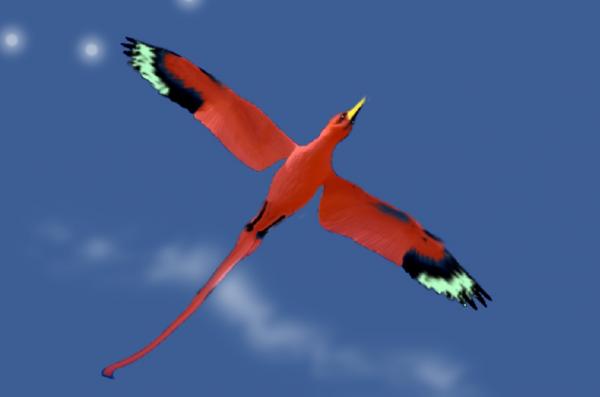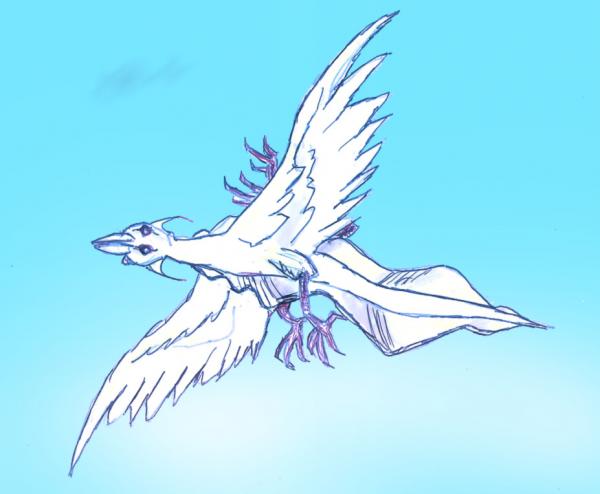BY LETTER
Freebirds
 Image from Steve Bowers | |
| A freefall Redbird, spliced from parrot, hummingbird and gannet sources; this species is tweaked to thrive in microgravity habitats - the long tail acts as an air anchor and assists the bird to maintain powered flight | |
The term 'Free Birds' refers to any subsophont, flight-capable, terrestrial avian-derived species tweaked for zero-G, atmospheric environments. The term is generally reserved for recognizably avian species, typically marked as having wings, legs, and beaks. Some derivatives of terrestrial avians have been engineered into truly exotic appearances discussed in "Related Species." Similarly, provolved avians with freefall modifications are not counted as free birds.
The basic free bird package was developed for the 195 AT Bigelow-Hilton Orbital, "Free Sphere-200." The idea may initially appear counterintuitive for anything besides the usual zero-G bone and metabolic modifications because birds are creatures of flight, but like humans they are very much evolved with gravity in mind. From their feet (often optimized to perch atop roosts in gravity) to their wings (designed to generate lift perpendicular to their motion) to their nests (arranged to cup and hold eggs against gravity), flying birds had many anatomical features inadequately suited for sustained free fall. Their instincts and reflexes were also often ill-suited for the environment, too.
Part of Bigelow-Hilton's motivation was the 185 AT Biosphere III debacle. Biosphere III was noted in the late Second Century AT as the only orbital with a substantial centripetal "gravity" section, but the large station also had a zero gravity atrium at its hub to welcome and impress visitors. Several attempts were made to introduce exotic song birds, but they adapted poorly and quickly died from issues ranging from bone decalcification, digestive issues, inability to nest and loss of eggs from nests, flying into objects, and inability to adapt flying patterns to free fall. (Interestingly, it took only modest gravity for birds to thrive. Those in lunar colonies' parks did quite well.) Biosphere III's problems were hardly the only problem faced by bionts in orbitals — human tweaks were subject to some horrible experiments in unregulated stations — but thanks to abundant video and virch images of distressed animals, the beautiful songbirds became a system-wide animal rights cause célèbre for six months that station management never forgot, because most managers at the time were fired. Since Bigelow-Hilton was building a 200-meter diameter free sphere hotel that would have garden platforms throughout its open volume and birds would contribute to its idyllic image, the free bird project was conceived. Several other companies were interested in the potential utility and profit offered by additional freefall adapted species, this being an era when the first space-adapted human programs were underway. The venture eventually tweaked several species.
The first free birds pioneered now-common changes: shoulder joint changes to allow different, higher angle-of-attack flapping and humming bird figure-eight beats; symmetrical wings for lift in either direction; additional primary feathers along the wing for thrust without lift; a more flexible neck for a wider field of view; feet suited for any-angle perches (gecko feet were trialed but not universal); and some modifications to instincts. Some of those modified instincts include producing a nest that will usually be enclosed, a pendant or spherical nest like those of weaver birds, with a few sticks or strands to secure eggs in place. Flight techniques and three dimensional awareness also required modification, though Bigelow-Hilton started with more intelligent species that adapted rapidly by learning.
Modern descendants of free birds have radically diversified and the modifications have been applied to many species of birds. Some may have minor changes such as now-widespread use of gecko feet to better work with the flat, slick surfaces common to Terragen spacecraft. Others may be suited for both gravity (adapted to or even able to exploit Coriolis effects in rotating habitats) and freefall. Oddly, few of the free bird species have ever been given vacuum adaptations, which tend to require radical changes beyond the the common definition of free bird.
The standard free bird tweak tends to retain the familiar form of terrestrial birds on aesthetic grounds, but Terragen space has a very broad range of aesthetics. Other leg modifications may reposition legs around the body or add more legs for better operation in free fall in the fashion of human microgravity tweaks. There have been attempts to eliminate legs all together, but these free birds are rarely successful. Avians typically use their hind limbs for manipulation of food, nests, and offspring. Also, additional eyes may be used to broaden vision.
RELATED SPECIES
 Image from Steve Bowers | |
| An advanced freebird variant, the Snaketail uses its broad rippling tailfins for propulsion, and has extra eyes and limbs to take advantage of its freedom of movement in 3D space | |
Free birds are not the only engineered zero-G avians. There are some that radically depart from the avian bodyplan, particularly those engineered for the largest free spheres and Niven rings. These typically have radical alterations to their wings, such as converting them to circular skirts around their shoulders for jellyfish-like propulsion. In denser atmospheric environments, avian derivatives have been created that propel themselves with rippling tails and tubular, peristaltic jets.
Other subsophont zero-G avian clades include those designed for a vacuum. Avians generally are not the first choice for a vacuum, which invalidates most of their body plan, but they have been adapted to vacuum life. The resulting species tend to fall into two groups: those that only need to propel themselves in vacuums for short distances, which tend to favor Jotunn-like hopping and gas propulsion, and those that will spend long periods between hard surfaces. The latter usually incorporate solar sail propulsion like Sailors of the Ebon Sea.
Related Articles
- African Grey Parrot
- Bird
- Free Fall - Text by M. Alan Kazlev
A state that occurs while in orbit around a planet or other body. During free fall, the orbiting object falls toward the planet the exact same amount as the planet's surface curves beneath the object; the object seems to be continually falling toward the planet but never reaches it. The result is a condition of weightlessness. - Freesphere
- Microgravity - Text by M. Alan Kazlev
A state in which gravity is reduced to virtually negligible levels. For example, when an object is in free fall, it experiences microgravity. It is deleterious to baseline physiology, but space-adapted tweaks can survive a microgravity environment indefinitely. - Microgravity Space Habitats
- Niven Clouds (Smoke Rings)
- Supenguins
- Twitterbird
Appears in Topics
Development Notes
Text by Mike Miller
Initially published on 27 September 2016.
Initially published on 27 September 2016.






